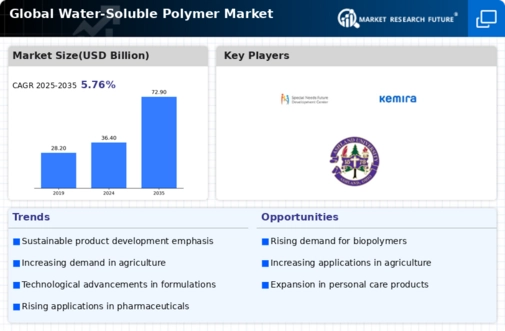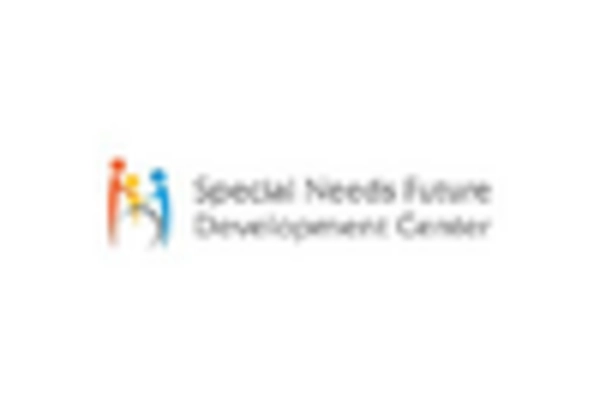-
Executive Summary
-
Scope of the Report
-
Market Definition
-
Scope of the Study
-
List of Assumptions
-
Markets Structure
-
Market Research Methodology
-
Research Process
-
Primary Research
-
Secondary Research
-
Market Size Estimation
-
Forecast Model
-
Market Factor Analysis
-
Supply Chain Analysis
- Raw Raw Material Suppliers
- Manufacturers/Service Providers of
- Distributors/Retailers/Wholesalers/E-Commerce
- End-Use Industries
-
Water-Soluble Polymers
-
Merchants
-
Porter’s Five Forces Model
- Threat of New Entrants
- Intensity of Competitive Rivalry
- Bargaining Power of Suppliers
- Bargaining
-
Threat of Substitutes
-
Power of Buyers
-
Pricing Analysis
-
Market Dynamics of Global Water-Soluble
-
Polymers Market
-
Introduction
-
Drivers
-
Restraints
-
Opportunities
-
Challenges
-
Global Water-Soluble Polymers Market,
-
by Raw Material
-
Introduction
-
Synthetic
- Market Estimates
- Market Estimates & Forecast, by Region,
-
& Forecast, 2023-2030
-
Natural
- Market Estimates & Forecast, 2023-2030
- Market Estimates & Forecast, by Region, 2023-2030
-
Semi-Synthetic
- Market Estimates & Forecast, 2023-2030
- Market Estimates &
-
Forecast, by Region, 2023-2030
-
Global Water-Soluble Polymers Market, by
-
Type
-
Introduction
-
Polyacrylamide and Copolymers
- Market
- Market Estimates & Forecast,
-
Estimates & Forecast, 2023-2030
-
by Region, 2023-2030
-
Guar Gum and Derivatives
- Market Estimates
- Market Estimates & Forecast, by Region,
-
& Forecast, 2023-2030
-
Gelatin
- Market Estimates & Forecast, 2023-2030
- Market Estimates & Forecast, by Region, 2023-2030
-
Polyvinyl
- Market Estimates & Forecast, 2023-2030
- Market
-
Alcohol
-
Estimates & Forecast, by Region, 2023-2030
-
Polyacrylic Acid
- Market Estimates & Forecast,
-
Market Estimates & Forecast, 2023-2030
-
by Region, 2023-2030
-
Casein
- Market Estimates & Forecast,
- Market Estimates & Forecast, by Region, 2023-2030
- Market Estimates & Forecast, 2023-2030
- Market Estimates
-
Others
-
& Forecast, by Region, 2023-2030
-
Global Water-Soluble Polymers Market,
-
by Application
-
Introduction
-
Wastewater Treatment
- Market
- Market Estimates & Forecast,
-
Estimates & Forecast, 2023-2030
-
by Region, 2023-2030
-
Cosmetic & Personal Car
- Market Estimates
- Market Estimates & Forecast, by Region,
-
& Forecast, 2023-2030
-
Oil & Gas
- Market Estimates & Forecast, 2023-2030
- Market Estimates & Forecast, by Region, 2023-2030
-
Food
- Market Estimates & Forecast,
-
Market Estimates & Forecast, 2023-2030
-
by Region, 2023-2030
-
Pulp & Paper
- Market Estimates &
- Market Estimates & Forecast, by Region, 2023-2030
-
Forecast, 2023-2030
-
Pharmaceuticals
- Market Estimates & Forecast, 2023-2030
-
Market Estimates & Forecast, by Region, 2023-2030
-
Others
- Market Estimates & Forecast,
-
Market Estimates & Forecast, 2023-2030
-
by Region, 2023-2030
-
Global Water-Soluble Polymers Market, by Region
-
Introduction
-
North America
- Market Estimates & Forecast,
- Market Estimates & Forecast, by Raw Material, 2023-2030
- Market Estimates & Forecast, by Type, 2023-2030
- Market Estimates
- US
-
& Forecast, by Application, 2023-2030
-
& Forecast, 2023-2030
-
Market Estimates & Forecast, by Application, 2023-2030
-
& Forecast, by Raw Material, 2023-2030
-
by Type, 2023-2030
-
Estimates & Forecast, by Type, 2023-2030
-
by Application, 2023-2030
-
Forecast, 2023-2030
-
Canada
-
Market Estimates & Forecast, 2023-2030
-
Market Estimates
-
Market Estimates & Forecast,
-
Market Estimates & Forecast, by Application,
-
Europe
- Market Estimates & Forecast, 2023-2030
- Market Estimates & Forecast, by Raw Material, 2023-2030
- Market
- Market Estimates & Forecast,
- Germany
-
Market Estimates & Forecast, by Application, 2023-2030
-
& Forecast, by Raw Material, 2023-2030
-
by Type, 2023-2030
-
France
-
Market Estimates & Forecast, 2023-2030
-
Market Estimates
-
Market Estimates & Forecast,
-
Market Estimates & Forecast, by Application,
-
Italy
-
Market Estimates & Forecast, 2023-2030
-
Market Estimates & Forecast, by Raw Material, 2023-2030
-
Market Estimates & Forecast, by Type, 2023-2030
-
& Forecast, by Application, 2023-2030
-
& Forecast, 2023-2030
-
Market Estimates
-
Spain
-
Market Estimates
-
Market Estimates & Forecast, by Raw Material,
-
Market Estimates & Forecast, by Type, 2023-2030
-
Market Estimates & Forecast, by Application, 2023-2030
-
Market Estimates & Forecast, 2023-2030
-
by Raw Material, 2023-2030
-
UK
-
Market Estimates & Forecast,
-
Market Estimates & Forecast, by Type,
-
Market Estimates & Forecast, by Application, 2023-2030
-
Russia
-
Market Estimates & Forecast, 2023-2030
-
Market Estimates & Forecast, by Raw Material, 2023-2030
-
Estimates & Forecast, by Type, 2023-2030
-
Forecast, by Application, 2023-2030
-
Estimates & Forecast, 2023-2030
-
by Raw Material, 2023-2030
-
Market
-
Market Estimates &
-
Rest of Europe
-
Market
-
Market Estimates & Forecast,
-
Market Estimates & Forecast, by Type,
-
Market Estimates & Forecast, by Application, 2023-2030
-
Asia Pacific
- Market Estimates & Forecast, 2023-2030
-
Market Estimates & Forecast, by Raw Material, 2023-2030
-
& Forecast, by Type, 2023-2030
-
Application, 2023-2030
-
Estimates & Forecast, by Application, 2023-2030
-
Market Estimates & Forecast, 2023-2030
-
by Raw Material, 2023-2030
-
Market Estimates
-
Market Estimates & Forecast, by
-
China
-
Market Estimates & Forecast,
-
Market Estimates & Forecast, by Raw Material, 2023-2030
-
Market Estimates & Forecast by Type, 2023-2030
-
Market
-
India
-
Market Estimates & Forecast,
-
Market Estimates & Forecast by Type,
-
Market Estimates & Forecast, by Application, 2023-2030
-
South Korea
-
Market Estimates & Forecast, 2023-2030
-
Market Estimates & Forecast, by Raw Material, 2023-2030
-
Estimates & Forecast by Type, 2023-2030
-
Forecast, by Application, 2023-2030
-
& Forecast, 2023-2030
-
Market
-
Market Estimates &
-
Indonesia
-
Market Estimates
-
Market Estimates & Forecast, by Raw Material,
-
Market Estimates & Forecast by Type, 2023-2030
-
Market Estimates & Forecast, by Application, 2023-2030
-
& New Zealand
-
Australia
-
Market Estimates & Forecast, 2023-2030
-
Market Estimates & Forecast, by Raw Material, 2023-2030
-
Estimates & Forecast, by Type, 2023-2030
-
Forecast, by Application, 2023-2030
-
Market Estimates & Forecast, 2023-2030
-
Forecast, by Raw Material, 2023-2030
-
by Type, 2023-2030
-
& Forecast, by Application, 2023-2030
-
Estimates & Forecast, 2023-2030
-
by Raw Material, 2023-2030
-
Market
-
Market Estimates &
-
Rest of Asia-Pacific
-
Market Estimates &
-
Market Estimates & Forecast,
-
Market Estimates & Forecast, by Application,
-
Middle East & Africa
- Market Estimates & Forecast,
- Market Estimates & Forecast, by Raw Material, 2023-2030
- Market Estimates & Forecast by Type, 2023-2030
- Market Estimates
- Turkey
- Israel
-
Market Estimates & Forecast, by Raw Material, 2023-2030
-
Estimates & Forecast, by Type, 2023-2030
-
Forecast, by Application, 2023-2030
-
Estimates & Forecast, 2023-2030
-
by Raw Material, 2023-2030
-
Market
-
Market Estimates &
-
North Africa
-
Market
-
Market Estimates & Forecast,
-
Market Estimates & Forecast, by Type,
-
Market Estimates & Forecast, by Application, 2023-2030
-
GCC
-
Market Estimates & Forecast, 2023-2030
-
Market Estimates & Forecast, by Raw Material, 2023-2030
-
Estimates & Forecast, by Type, 2023-2030
-
Forecast, by Application, 2023-2030
-
& Forecast, by Raw Material, 2023-2030
-
by Type, 2023-2030
-
Estimates & Forecast, by Type, 2023-2030
-
by Application, 2023-2030
-
Forecast, 2023-2030
-
Market
-
Market Estimates &
-
Rest of the Middle East & Africa
-
Market Estimates & Forecast, 2023-2030
-
Market Estimates
-
Market Estimates & Forecast,
-
Market Estimates & Forecast, by Application,
-
Latin America
- Market Estimates & Forecast, 2023-2030
- Market Estimates & Forecast, by Raw Material, 2023-2030
- Market
- Market Estimates & Forecast,
- Brazil
-
Market Estimates & Forecast, by Application, 2023-2030
-
& Forecast, by Raw Material, 2023-2030
-
by Type, 2023-2030
-
Argentina
-
Market Estimates & Forecast, 2023-2030
-
Market Estimates
-
Market Estimates & Forecast,
-
Market Estimates & Forecast, by Application,
-
Mexico
-
Market Estimates & Forecast, 2023-2030
-
Market Estimates & Forecast, by Raw Material, 2023-2030
-
Market Estimates & Forecast, by Type, 2023-2030
-
& Forecast, by Application, 2023-2030
-
Market Estimates & Forecast, 2023-2030
-
by Raw Material, 2023-2030
-
Market Estimates
-
Rest of Latin America
-
Market Estimates & Forecast,
-
Market Estimates & Forecast, by Type,
-
Market Estimates & Forecast, by Application, 2023-2030
-
Competitive Landscape
-
Introduction
-
Market Key Strategies
-
Key Development Analysis
-
(Expansions/Mergers & Acquisitions/Joint
-
Ventures/New Product Developments/Agreements/Investments)
-
Competitive
-
Benchmarking
-
Company Profiles
-
SNF Group
- Company Overview
- Financial Overview
- Products Offered
- Key Developments
- SWOT Analysis
- Key Strategies
-
Kemira
- Company
- Financial Overview
- Products Offered
- SWOT Analysis
- Key Strategies
- Company Overview
- Financial Overview
- Key Developments
- SWOT Analysis
-
Overview
-
Key Developments
-
BASF SE
-
Products Offered
-
Key Strategies
-
Ashland
- Company Overview
- Financial
- Products Offered
- Key Developments
- SWOT
- Key Strategies
-
Overview
-
Analysis
-
KURARAY CO., LTD
- Company
- Financial Overview
- Products Offered
- SWOT Analysis
- Key Strategies
- Company Overview
- Financial Overview
- Products
- Key Developments
- SWOT Analysis
- Key Strategies
-
Overview
-
Key Developments
-
DuPont
-
Offered
-
Arkema S.A.
- Company Overview
- Financial Overview
- Products Offered
- Key Developments
- SWOT Analysis
- Key Strategies
-
The Dow Chemical Company
- Company Overview
- Financial Overview
- Products Offered
- Key Developments
- SWOT Analysis
- Key Strategies
-
Nitta Gelatin, NA Inc.
- Company Overview
- Financial Overview
- Products Offered
- Key Developments
- SWOT Analysis
- Key Strategies
-
Gantrade Corporation
- Company Overview
- Financial
- Products Offered
- Key Developments
- Key Strategies
-
Overview
-
SWOT Analysis
-
Akzo Nobel N.V.
- Financial Overview
- Products Offered
- Key Developments
- SWOT Analysis
- Key Strategies
-
Company Overview
-
Sumitomo Seika Chemicals Co., Ltd.
- Company Overview
- Products Offered
- Key Developments
- SWOT Analysis
- Key Strategies
-
Financial Overview
-
CP Kelco U.S.
- Company Overview
- Financial Overview
- Products
- Key Developments
- SWOT Analysis
- Key
-
Offered
-
Strategies
-
Shandong polymers Bio-chemicals Co. Ltd.
- Company
- Financial Overview
- Products Offered
- SWOT Analysis
- Key Strategies
- Company Overview
- Financial
- Products Offered
- Key Developments
- Key Strategies
-
Overview
-
Key Developments
-
Mitsubishi Chemical Corporation
-
Overview
-
SWOT Analysis
-
Appendix
-
-
LIST OF TABLES
-
Global Water-Soluble Polymers Market, by Region, 2023-2030
-
North America: Water-Soluble Polymers Market, by Country, 2023-2030
-
Europe: Water-Soluble Polymers Market, by Country, 2023-2030
-
Table
-
Asia-Pacific: Water-Soluble Polymers Market, by Country, 2023-2030
-
Table
-
Middle East & Africa: Water-Soluble Polymers Market, by Country, 2023-2030
-
Latin America: Water-Soluble Polymers Market, by Country, 2023-2030
-
Global Water-Soluble Polymers Raw Material Market, by Region, 2023-2030
-
North America: Water-Soluble Polymers Raw Material Market, by Country,
-
Europe: Water-Soluble Polymers Raw Material Market, by Country,
-
Asia-Pacific: Water-Soluble Polymers Raw Material Market,
-
by Country, 2023-2030
-
Middle East & Africa: Water-Soluble Polymers
-
Raw Material Market, by Country, 2023-2030
-
Latin America: Water-Soluble
-
Polymers Raw Material Market, by Country, 2023-2030
-
Global Water-Soluble
-
Polymers Type Market, by Region, 2023-2030
-
North America: Water-Soluble
-
Polymers Type Market, by Country, 2023-2030
-
Europe: Water-Soluble
-
Polymers Type Market, by Country, 2023-2030
-
Asia-Pacific: Water-Soluble
-
Polymers Type Market, by Country, 2023-2030
-
Middle East & Africa:
-
Water-Soluble Polymers Type Market, by Country, 2023-2030
-
Latin America:
-
Water-Soluble Polymers Type Market, by Country, 2023-2030
-
Global Water-Soluble
-
Polymers Application Market, by Region, 2023-2030
-
North America: Water-Soluble
-
Polymers Application Market, by Country, 2023-2030
-
Europe: Water-Soluble
-
Polymers Application Market, by Country, 2023-2030
-
Asia-Pacific: Water-Soluble
-
Polymers Application Market, by Country, 2023-2030
-
Middle East &
-
Africa: Water-Soluble Polymers Application Market, by Country, 2023-2030
-
Table
-
Latin America: Water-Soluble Polymers Application Market, by Country, 2023-2030
-
Global Raw Material Market, by Region, 2023-2030
-
Global
-
Type Market, by Region, 2023-2030
-
Global Application Market, by Region,
-
North America: Water-Soluble Polymers Market, by Country,
-
North America: Water-Soluble Polymers Market, by Raw Material,
-
North America: Water-Soluble Polymers Market, by Type, 2023-2030
-
North America: Water-Soluble Polymers Market, by Application, 2023-2030
-
Europe: Water-Soluble Polymers Market, by Country, 2023-2030
-
Table
-
Europe: Water-Soluble Polymers Market, by Raw Material, 2023-2030
-
Table
-
Europe: Water-Soluble Polymers Market, by Type, 2023-2030
-
Europe:
-
Water-Soluble Polymers Market, by Application, 2023-2030
-
Asia-Pacific:
-
Water-Soluble Polymers Market, by Country, 2023-2030
-
Asia-Pacific:
-
Water-Soluble Polymers Market, by Raw Material, 2023-2030
-
Asia-Pacific:
-
Water-Soluble Polymers Market, by Type, 2023-2030
-
Asia-Pacific: Water-Soluble
-
Polymers Market, by Application, 2023-2030
-
Middle East & Africa:
-
Water-Soluble Polymers Market, by Country, 2023-2030
-
Middle East &
-
Africa: Water-Soluble Polymers Market, by Raw Material, 2023-2030
-
Table 42
-
Middle East & Africa: Water-Soluble Polymers Market, by Type, 2023-2030
-
Table
-
Middle East & Africa: Water-Soluble Polymers Market, by Application, 2023-2030
-
Latin America: Water-Soluble Polymers Market, by Country, 2023-2030
-
Latin America: Water-Soluble Polymers Market, by Raw Material, 2023-2030
-
Latin America: Water-Soluble Polymers Market, by Type, 2023-2030
-
Table
-
Latin America: Water-Soluble Polymers Market, by Application, 2023-2030
-
LIST
-
OF FIGURES
-
Global Water-Soluble Polymers Market Segmentation
-
FIGURE
-
Forecast Research Methodology
-
Porter’s Five Forces Analysis
-
of Global Water-Soluble Polymers Market
-
Value Chain/Supply Chain of
-
Global Water-Soluble Polymers Market
-
Share of Global Water-Soluble
-
Polymers Market, by Country, 2020 (%)
-
Global Water-Soluble Polymers
-
Market, 2023-2030
-
Global Water-Soluble Polymers Market Size, by Raw
-
Material, 2020 (%)
-
Share of Global Water-Soluble Polymers Market,
-
by Raw Material, 2023-2030
-
Global Water-Soluble Polymers Market Size,
-
by Type, 2020 (%)
-
Share of Global Water-Soluble Polymers Market,
-
by Type, 2023-2030
-
Global Water-Soluble Polymers Market Size, by
-
Application, 2020 (%)
-
Share of Global Water-Soluble Polymers Market,
-
by Application, 2023-2030

















Leave a Comment